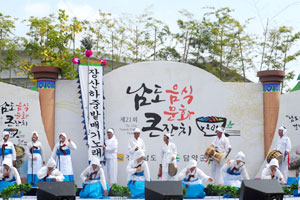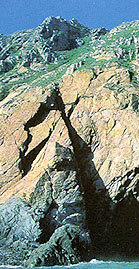
Jangsan-myeon, Shinan-gun
Jangsan-myeon where Jangsando field songs are embroidering the fields
Field songs of Jangsando are representative folk songs of Shinan that are cheerful but hold the sorrow of the lonely island village and inner sentiment. They received the Grand Prize in the 12th Namdo Cultural Contest on November 11, 1981 and the Prime Minister Prize in the 23rd National Folk Art Contest on October 26, 1982.
The mountain is connected from Oheum mountain to Baemi mountain, Daeseong mountain, pigeon mountain, Buhak mountain, the mountain in the back of Donggyo, and Hwalmok endlessly and is called Jang (long) mountain. No high mountains exist and mountains and hills were cultivated and turned into fields. Tidal lands were filled and then turned into rice paddies and salterns for rice/barley farming. Due to the enough rainfalls under the maritime climate, plants grow well and many kinds of agricultural products are produced.
Fisheries were not developed and by using the blessed mudflats, in the coast, green algae aquaculture is actively conducted.
Jangsando is located in the southernmost area among islands of Shinan-gun and thus, is a gateway to the far sea.
Fisheries were not developed and by using the blessed mudflats, in the coast, green algae aquaculture is actively conducted.
Jangsando is located in the southernmost area among islands of Shinan-gun and thus, is a gateway to the far sea.

Its historical/cultural importance became higher as the time rolled up to the past; the importance was higher in Chosun era than now, much higher in Koryo era, Unified Shilla era, and even further higher in Mahan, Three-State era and it was because centering
around this area, the route for maritime trade was developed greatly. The traditional route between Chinese contient and Korea was Nocheolsan waterway, which started from Yeondae of Sandong peninsula, passed Balhae bay where 200 islands were lined up, Yeosun at the tip of Yodong peninsula, Daeryeon, the end of Aprok river, along the Korean peninsula west coastline and down to the archipelago of the southwest sea. This route following the coastline was comparatively smooth and from the old days, listed as a safe waterway route even for small ships and the islands area of the southwest sea became the center of maritime trade route that connected Korean peninsula, China and Japan and took even more important positions than the land. It was said that when the land people did not know about what happened in the palace even in a few months but in this island area, it took only a week to hear the news about the palace in the island. It means that not only resources but information was traded here.
Jangsando used to be Jangsan hyeon, which means that it was the center of administration of the islands in the southwest sea and therefore, there are many historic relics. Nogeo forest (101 trees) in Ushijandeung, Dochang-ri testified the long history of Jangsando. In speaking of Jangsando, one thing that cannot be missed is 'Jangsando field song' designated as Regional Intangible Cutural Asset No. 21. Jangsan field songs are sung in the rice-transplanting season to pray for the abundant harvest and have unique rhythm. In each chapter, there are variations in rhythm and the enchanting songs rhythm move from jungmori to jungjungmori.
Field songs of Jangsando are representative folk songs of Shinan that are cheerful but hold the sorrow of the lonely island village and inner sentiment. They received the Grand Prize in the 12th Namdo Cultural Contest on November 11, 1981 and the Prime Minister Prize in the 23rd National Folk Art Contest on October 26, 1982. Still Buja Kang and other artisans and initiates pass the songs down to decendents and during every vacation, college students come from all over the country to learn 'Jangsando field songs'. In Gongsu-ri, there is a building for teaching field songs of Jangsando and a monument for the songs.
In the fields of Jangsan, other songs are sung as well such as Hajung field cultivation songs, songs for shaman's ritual for cleansing dead person's soul and weaving songs. As other cultural heritage, there are stone tumb in Dochang-ri, Daeri dolmens, Jangsan earthern ramparts site, Daeseong mountain fortress, grave of Byeong-Jun Jang, Jangsan ranch site, etc.
around this area, the route for maritime trade was developed greatly. The traditional route between Chinese contient and Korea was Nocheolsan waterway, which started from Yeondae of Sandong peninsula, passed Balhae bay where 200 islands were lined up, Yeosun at the tip of Yodong peninsula, Daeryeon, the end of Aprok river, along the Korean peninsula west coastline and down to the archipelago of the southwest sea. This route following the coastline was comparatively smooth and from the old days, listed as a safe waterway route even for small ships and the islands area of the southwest sea became the center of maritime trade route that connected Korean peninsula, China and Japan and took even more important positions than the land. It was said that when the land people did not know about what happened in the palace even in a few months but in this island area, it took only a week to hear the news about the palace in the island. It means that not only resources but information was traded here.
Jangsando used to be Jangsan hyeon, which means that it was the center of administration of the islands in the southwest sea and therefore, there are many historic relics. Nogeo forest (101 trees) in Ushijandeung, Dochang-ri testified the long history of Jangsando. In speaking of Jangsando, one thing that cannot be missed is 'Jangsando field song' designated as Regional Intangible Cutural Asset No. 21. Jangsan field songs are sung in the rice-transplanting season to pray for the abundant harvest and have unique rhythm. In each chapter, there are variations in rhythm and the enchanting songs rhythm move from jungmori to jungjungmori.
Field songs of Jangsando are representative folk songs of Shinan that are cheerful but hold the sorrow of the lonely island village and inner sentiment. They received the Grand Prize in the 12th Namdo Cultural Contest on November 11, 1981 and the Prime Minister Prize in the 23rd National Folk Art Contest on October 26, 1982. Still Buja Kang and other artisans and initiates pass the songs down to decendents and during every vacation, college students come from all over the country to learn 'Jangsando field songs'. In Gongsu-ri, there is a building for teaching field songs of Jangsando and a monument for the songs.
In the fields of Jangsan, other songs are sung as well such as Hajung field cultivation songs, songs for shaman's ritual for cleansing dead person's soul and weaving songs. As other cultural heritage, there are stone tumb in Dochang-ri, Daeri dolmens, Jangsan earthern ramparts site, Daeseong mountain fortress, grave of Byeong-Jun Jang, Jangsan ranch site, etc.

